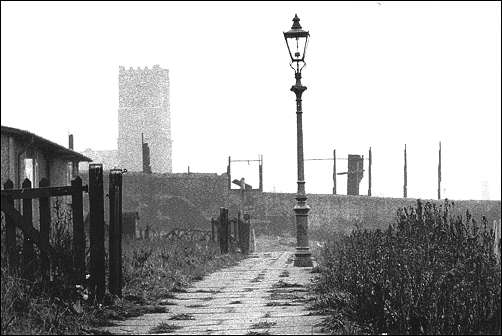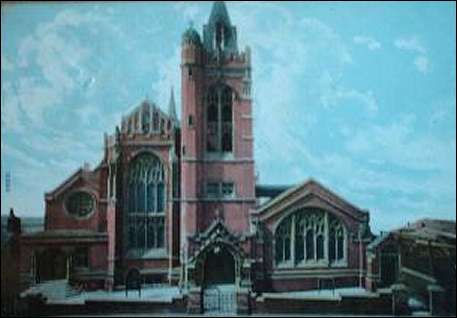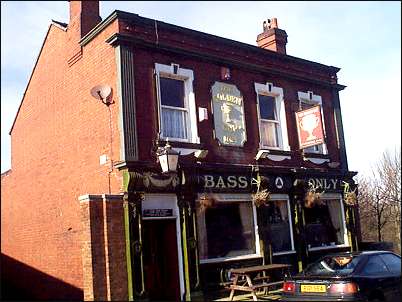|
Old Town Road, Hanley
 
click the
"contents" button to get back to the main index & map
next: Bournes Bank, Burslem
|
Historian Fred Hughes
writes....
“The routes of forgotten roads fascinate me,” declares Potteries’
historian Steve Birks. “The Potteries’ terrain has changed so much that if
you brought people back who lived here fifty years ago they simply
wouldn’t recognise the place. Take Old Town Road for instance. All you see
now is a short cu-de-sac stripped bare of a thriving community that once
lived and worked here. It was a thrilling gateway that led to the heart of
Hanley. Now it is a rump of road that leads nowhere.”
He’s right. To use the archaic pub symbols Old Town Road once stretched a
half mile from the town centre Angel to the Plough at Providence Square.
“It was filled with pedestrian activity,” recalls former resident
67 year old Ken Buckley. “My family arrived in 1952 when it was called
High Street lined with houses, shops, potbanks and collieries.
At the top of Union Street were dozens of lines of prefab bungalows
erected for emergency accommodation after the war replacing the
cleared-away slums from Wood Street and Bryan Street.

Hanley near the top of
Union and Hanover Streets - 1959
On the left can be seen
the end of a row of post-World War II 'prefabs' (prefabricated houses),
the church tower is that of St. John's in Town Road and posts are the
remains of the Port Vale football ground. This area is now occupied by
the multi-story car park to the Potteries Shopping centre.
photo: Donald Morris

The
Tabernacle (Congregational), Town Road
to the right of
the picture can be seen the coal mine spoil heaps
Postcard c.1905
Half way along was St John’s church. It’s still there but the tabernacle
that stood close by was demolished in 1964. An earlier Tabernacle stood
opposite which was used until 1960 as the Ideal Skating Rink. It’s
impossible to see exactly where any of this was since the demolition of
the general market in 1981 replaced by the Potteries Shopping Centre,
and the opening of the Potteries Way in 1986. This ring-road cut away
the lower half of Hillchurch Street, Mayer Street and the adjacent
terraces of Gladstone Street and Arbour Street. And fourteen pubs were
demolished during this period.”
|
This is something Ken knows a lot about for three generations of
his family, his father and mother Ken and Betty, himself, then his son
Steve, kept the last one of those pubs which happily is still open for
business – the Golden Cup.
“Altogether the Cup was in the family for fifty-five years. It has to be
something of a record,” claims Ken proudly. “We only moved out last year
so I think the Buckley family did its bit for the Old Town Road.”
These days, if you approach Hanley from Providence Square on foot, you
have a devil of a job walking across the overpass where the main traffic
route was diverted across the land the prefabs stood on to the east of Bow
Street. And you can still see a bit of Bow Street as a stubby remnant just
behind the Golden Cup.
“Somewhere here, back-to-back with the Cup was a small pub called the
Ramping Horse,” recalls Ken. “Between the chapel and the two pubs was a
public thoroughfare, called the Slabs. They say that Bow Street was a
lawless area occupied by Irish labourers. I heard that the police would
only patrol in twos and only then when they were accompanied by a priest.”
|
The new owners of the Golden Cup are Stephanie Hill and Alan Ball.
“We took over from the Buckley’s a year ago,” says Stephanie. “And you
just can’t get away from the wonderful atmosphere of this great
traditional pub.”
Stephanie mentions particularly the restored Victorian décor put in place
by Ken before he left. But it’s the tiled façade that grabs the eye
complete with the original Edwardian green-glazed tiles.

“Old Town Road is just a few hundred yards log now,” Alan points out. “I
think it would be a terrific plan to restore the whole length of it. Take
up the tarmac and put the original cobblestones back. The old Falcon
Pottery with its bottle oven is still there and would make wonderful town
centre accommodation. Then there’s the chapel that’s already been restored
which is doing great business which we benefit from.”
The building Alan refers to is the former Wesleyan Chapel opposite the
Falcon Works. Built in 1860 it became a Spiritualist church until it
finally closed a few years ago. These days it has been converted into a
restaurant by local businesswoman Diane McDaid.
“I came across it when it was on the market and immediately fell in love
with it,” says Diane. “There was no need to change its structure. I simply
wanted to preserve the entire essential ambience so that diners had a
feeling of being somewhere historic and special.”
There’s something of a wow factor when you climb the stairs to the huge
dining room, once the chapel’s main auditorium. Five arched stain-glass
windows gather natural light and transform it into pale aquamarines and
feldspar pinks allowing it to fall across the whole dining area. It is a
restaurant yes, but you can still feel the church.
|
“It’s worth remembering that in the early 18th century Hanley was a very
poor district,” continues Steve Birks. “Meagre worker’s cottages lay
chiefly around Upper Green which then at the junction of Keelings Road and
the present Town Road. Upper Green was separated from the next community
Lower Green which is now Hanley Market Square. Between these were mines,
clay pits, tile works and potbanks.
Both these communities were situated half a mile apart. This is why each
community had its own services such as pubs and chapels. They were two
communities that became one when they joined to become High Street. We saw
much of that start to change in the 1960s with various slum clearance
programmes. Then the colliery closed down and by the end of the 1960s the
whole area was left as a bleak and empty wasteland. It was a place to pass
through and not to stay.”
Yet all that changed in 1971 on with the council’s reclamation scheme to
create the Central Forest Park. Now 49 hectares of parkland provide a
sanctuary for wildlife and a superb community playground.
“It is exciting to follow the lost roads of the Potteries,” concludes
Steve. “They serve to remind us how important it is to know where we came
from.”
 see
more on Old Town Road
see
more on Old Town Road |
![]()
![]()